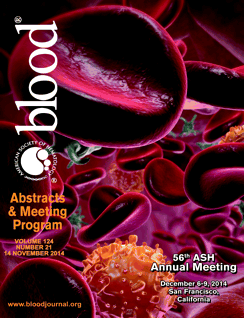Abstract

In acute myeloid leukemia (AML) high expression of the transcription factor ERG (ETS related gene) is associated with dismal outcome. The mechanisms that regulate differential ERG expression remain to be fully elucidated. MicroRNAs (miRs), small RNAs that are able to regulate gene expression, have emerged as important players in AML. We hypothesized that part of the differential expression of ERG is mediated by miRs. In silico prediction tools identified three putative miR-9 binding sites (BS) in the 3'-untranslated region (UTR) of ERG.
First, we determined the expression levels of ERG & miR-9 in eight leukemia cell lines (i.e. KG1a, K562, THP-1, MV4-11, EOL1, NB4, OCI-AML3 & ME1) & found an inverse correlation between ERG & miR-9 expression (rank correlation -0.90). The cell line KG1a had the highest ERG & low miR-9 expression, and was therefore used for miR-9 overexpression experiments. In these cells miR-9 overexpression decreased ERG expression at the mRNA level to 82±7% (P=.079) & at the protein level to 72±14% (P=.005) after 12 hours (h) compared to empty vector control transfected cells. Next, we tested the activity of the three putative miR-9 BS in the 3'-UTR of ERG using luciferase assays. 12 h after cotransfection of HEK-293T cells with a miR-9 overexpression vector & an appropriate luciferase vector containing two of the putative BS (BS1 & BS2) from the 3'-UTR of ERG, we found the luciferase activity reduced to 52±4% (P=.023). Mutation experiments showed BS1, but not BS2 to be essential for this activity. The insertion of BS3 into the luciferase vector had no effect on reporter gene expression. Thus miR-9 most likely regulates expression of the transcription factor ERG by directly binding to BS1 in its 3'-UTR.
To test if a differential expression of miR-9 is also of functional significance in AML, we first analyzed its impact on cell proliferation. Overexpression of miR-9 led to decreased proliferation rates in KG1a cells compared to control vector treated cells. After 5 days, the relative cell count was 133±21% vs. 241±67% in the miR-9 overexpressing cells compared to empty vector expressing cells, respectively. Next, we determined if this difference was based on a higher apoptosis rate. An Annexin V staining revealed no significant difference between the apoptotic threshold of miR-9 overexpressing (21%) and empty vector cells (21%) after 24 h. However, a subsequent cell cycle analysis demonstrated a higher percentage of miR-9 overexpressing cells in the G2/M phase, (39±2%) compared to the empty vector control treated cells (31±3%) after 24 h (P=.084), indicating that the cell cycle is slowed or stopped during cell division.
Since miR-9 targets the poor prognostic marker ERG & higher miR-9 expression led to decreased proliferation & reduced cycling in AML cells in vitro we speculated that the differential miR-9 expression would also impact the outcome of AML patients (pts).
Mature miR-9 is derived from three precursor molecules of which pre-miR-9-1 & pre-miR-9-3 are known to be expressed in hematopoietic cells. We assessed the pre-miR-9-1 expression of bone marrow by real-time PCR in 131 AML pts (median age 64 [range 22 – 75] years) with favorable (n=4, 3%), intermediate (n=90, 69%), adverse (n=33, 25%), or unknown (n=4, 3%) cytogenetic risk (according to the Medical Research Council [MRC] Classification) who received a RIC-HCT. The median follow-up was 4 years. The pre-miR-9-1 expression levels were normalized to ABL to define high & low pre-miR-9-1 expressers by the median expression of all AML pts. At diagnosis, high pre-miR-9-1 expresser status associated with a lower white blood count (P=.065) and lower % of peripheral blasts (P=.108) by trend. Furthermore, pts with high pre-miR-9-1 expression were more likely to be NPM1 wild-type (P=.047) & FLT3-ITD negative (P=.020). Pts with high pre-miR-9-1 had a lower probability of relapse (P=.048).
In conclusion, miR-9 targets & regulates expression of the poor outcome predictor ERG. Overexpression of miR-9 led to decreased proliferation and a pause in AML cell cycling. Furthermore, high pre-miR-9-1 expression associated with reduced relapse rates in AML. Thus a pharmacologically induced expression of miR-9 in AML blasts may improve outcomes of AML pts.
No relevant conflicts of interest to declare.
Author notes
Asterisk with author names denotes non-ASH members.

This icon denotes a clinically relevant abstract

